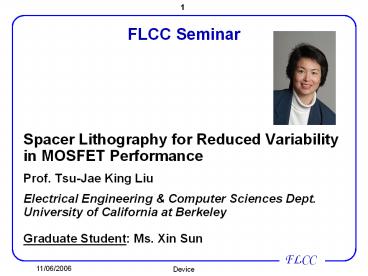Spacer Lithography for Reduced Variability - PowerPoint PPT Presentation
1 / 27
Title:
Spacer Lithography for Reduced Variability
Description:
FLCC Seminar Spacer Lithography for Reduced Variability in MOSFET Performance Prof. Tsu-Jae King Liu Electrical Engineering & Computer Sciences Dept. – PowerPoint PPT presentation
Number of Views:120
Avg rating:3.0/5.0
Title: Spacer Lithography for Reduced Variability
1
FLCC Seminar
- Spacer Lithography for Reduced Variability
- in MOSFET Performance
- Prof. Tsu-Jae King Liu
- Electrical Engineering Computer Sciences Dept.
- University of California at Berkeley
- Graduate Student Ms. Xin Sun
2
Outline
- Introduction
- MOSFET scaling
- Lithography challenges
- Spacer Lithography
- Device Simulation Study
- Summary and Future Work
3
IC Technology Advancement
Improvements in IC performance and cost have been
enabled by the steady miniaturization of the
transistor
Transistor Scaling
YEAR 2004 2007 2010 2013 2016
HALF-PITCH 90nm 65nm 45nm 32nm 22nm
4
The Bulk-Si MOSFET
Metal-Oxide-Semiconductor Field-Effect Transistor
Gate
- Desired characteristics
- High ON current
- Low OFF current
Source
Drain
Substrate
- Current flowing between the SOURCE and DRAIN is
controlled by the voltage on the GATE electrode
- N-channel P-channel MOSFETs operate in a
complementary manner - CMOS Complementary MOS
5
VT Roll-Off
M. Okuno et al., 2005 IEDM p. 52
- VT decreases with Lg
- Effect is exacerbated by
- high values of VDS
- Qualitative explanation
- The source drain p-n junctions assist in
depleting the Si underneath the gate. The
smaller the Lg, the greater the percentage of
charge balanced by the S/D p-n junctions
D
Large Lg
S
D
S
Small Lg
6
Sub-Threshold Leakage
log ID
ION, high VT
IOFF, high VT
VG
0
- Leakage current varies exponentially with VT
- S 60mV/dec at room temperature, due to thermal
distribution of carriers within energy bands - typically 80-100 mV/dec for a bulk-Si MOSFET
7
Parametric Yield
- High-performance processors are speed-binned
- Faster chips more
- (These parts have smaller Lg)
- Leakage is exponentially dependent on VT f(Lg)
TOO LEAKY
TOO SLOW
- Since leakage is now appreciable, parametric
yield - is being squeezed on both sides
? Tighter control of Lg will be needed with
scaling!
8
The Sub-Wavelength Gap
9
Achieving Sub-Wavelength Resolution
courtesy M. Rieger (Synopsys, Inc.)
10
Geometrical Regularity for Improved Yield
Configurable logic block layout
- A geometrically regular layout should be used to
improve the fidelity of printed sub-wavelength
features. - All MOSFETs are oriented along the same direction
- Gate lines are placed at regular spacings
L. Pillegi et al., 2003 DAC p. 782
11
Mask Cost Considerations
Mask cost escalates with technology advancement!
(minimum half-pitch)
? It will eventually be more cost effective to
use multiple lower-cost masks to
define the most critical layer (gate)
12
Outline
- Introduction
- Spacer Lithography
- Process flow
- Application to gate patterning
- Device Simulation Study
- Summary and Future Work
13
Spacer Lithography Process
hard mask (SiO2)
poly-Si gate layer
gate dielectric
Si
Note that pitch is 2? that of patterned layer!
14
High-Density Feature Formation
2n lines after n iterations of spacer lithography!
15
Spacer vs. Resist Lithography
- Spacer lithography yields superior CD uniformity
Y.-K. Choi et al., IEEE Trans. Electron Devices,
Vol. 49, p. 436, 2002
16
Gate Patterning using Spacer Lithography
- Define fine-line features in a hard-mask layer
using spacer lithography - regular geometry (lines and spaces)
- Lg lt l pitch P l
- Pattern fine-line features (to remove hard-mask
where gate lines are not desired) - minimum feature size gt P
- alignment tolerance P ? Lg
- Define large features in a resist layer using
photolithography - minimum feature size ? P
- alignment tolerance gtLg
17
Spacer Gate Patterning Benefits
- Provides fine-line gate electrodes oriented in
parallel and laid out on a regular grid - Minimizes feature variations for improved yield
- Facilitates RET to achieve smallest possible
feature sizes - ? tight control of Lg ? high parametric
yield - Note that the geometrically regular mask (Step 1)
can be used for multiple chip designs, to save
cost
18
Achieving Uniform Gate Length
Gate formation by spacer lithography ? uniform Lg
Lg
Fin formation by conventional lithography ?
non-uniform Lg
Lg
Y.-K. Choi et al., IEDM Technical Digest, pp.
259-262, 2002
19
Outline
- Introduction
- Spacer Lithography
- Device Simulation Study
- Approach
- Initial results
- Summary and Future Work
20
Approach
- Use 3-D device simulations (Sentaurus Device) to
investigate the benefits of spacer gate
lithography - nominal Lg lt 40nm
- Sources of variation include
- Lg variations
- line-edge roughness (LER)
- statistical dopant fluctuations (SDF)
21
EUV Resist LER Data from AMD
Average CD 37.9nm Standard Deviation 1.7nm
22
Impact of S/D Implant Anneal Conditions
Spike 1100C 1s
Flash 1300C 1ms
RTA 1000C 10s
S/D ext. implant 3E14 As cm-2 _at_ 3keV Trend
toward diffusion-less anneal ? increased junction
roughness
23
Device Simulation Methodology
LER Generation
Structure Generation
Device Simulation
Lg 37nm Xj 20.4nm Tox 1.2nm Nbody
2.2E18cm-3 Assume S/D junction follows LER
profile.
Sentaurus 3D Device simulation Collect
statistical distributions of ION and IOFF
Wchannel 50nm
24
Simulated MOSFET Structures
Resist Lithography
Spacer Lithography
Plan View (gate electrode)
Isometric View
Plan View (gate electrode)
Isometric View
25
Initial Results
Smaller spread in IOFF vs. ION is seen for spacer
gate lithography
26
Outline
- Introduction
- Spacer Lithography
- Device Simulation Study
- Summary and Future Work
27
Summary
- Tighter control of Lg will be needed with
transistor scaling however, this becomes more
difficult as the sub-wavelength gap increases - Spacer lithography provides for better CD
control, and will eventually be a more
cost-effective approach than conventional resist
lithography for patterning gate electrodes - LER effects on MOSFET performance can be
mitigated by spacer gate lithography
Future Work
- Assess the relative impacts of various sources of
variability (line-width variations, LER, SDF)































